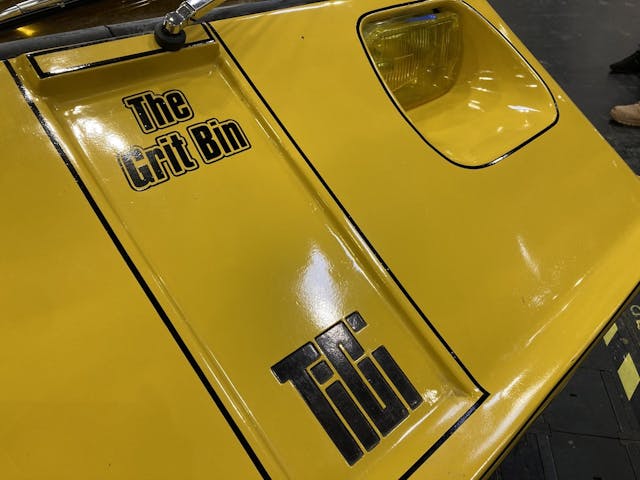Paul Wylde’s Truly Titchy TiCi Kit Car
The Mini. Famously a very small car. It’s right there in the name, even. But since 1959, a truly astonishing number of people have attempted to make it even smaller, be that by lopping a section from the middle to create the familiar “shorty” Minis, by chopping the roof à la Minisprint, removing almost all the bodywork for an autocross car, or simply by transplanting the Mini’s gizzards into a low-slung kit car like a Cox GTM or a Unipower GT.
Few Mini-based machines come smaller than the TiCi, though. Pronounced “titchy”, it’s a wholly appropriate name for a wonderfully silly vehicle, and rarely has something so small had such big presence; at the 2024 Classic Car & Restoration Show at the NEC, there were people climbing in and out of it all day.

Well, attempting to, anyhow. Owner Paul Wylde, who owns two TiCis, invited me to contort myself into its driver’s seat, and I think I nearly snapped in two. The suggested method is to stand on the seat just ahead of the steering wheel—well, not so much stand as balance yourself in the fetal position, since the roof gets in the way of standing—and then feed your legs beneath the wheel.
Once you’re in, it’s cozy but not cramped, in much the same way a Lotus Elise a challenge to enter but is much better when you’re installed. I’ve gotten into Elises and Caterhams with their roofs in place before, and having gotten into this TiCi I now realize that I had nothing to fear from them. “Designed for a jockey” is a popular refrain for any car with small living quarters. The TiCi feels more like it was designed for a 10-year-old gymnast.


“This car’s a 1972 pre-production prototype,” Wylde explains. “They were made by a furniture designer in Leicestershire, and they built roughly 40 of them.”
That designer is Anthony Hill, who’s been knocking around ideas for Mini-based kits since the early 1960s, specifically around the idea of a ‘square’ car, with the same wheelbase and track width. The TiCi arrived on the scene in 1972, both measurements were just 50 inches, against a wheelbase in the standard Mini of around 80 inches.

As reported by Autocar in January 1972, Hill sought companies to build the car he’d designed, and the body fell to Bourne Plastics, “which was involved with the first 500 Elise bodies,” says Wylde. “But they were also making nose cones for British Rail’s InterCity trains. And as it happens, all these TiCis were yellow – exactly the same yellow as the nose of those trains.” Raymond Mays of ERA was later involved, and there are publicity photos of Stirling Moss with a pair of TiCis buzzing around London as well, which must have been quite a sight.

That color’s still hard to miss, too, not least because Wylde has enhanced it with a couple of yellow covers for the Vauxhall Viva–sourced headlights, and the entire windscreen is also yellow tinted, too—perfectly legally, since enough light passes through. The effect is remarkable, like being inside a 1970s Hot Wheels toy.
The chassis is made from two fiberglass moldings, an outer and an inner, and the roof is a separate and removable panel. Wylde built it from the original molds, and for the doors he had molds made from another TiCi. When finally installed, they’ll hinge forward and upward, not unlike some supercars. With them closed, it’ll doubtless be an even more cozy experience.
Probably quite noisy, too, with the A-series engine sitting just behind your back, beneath the fiberglass. Hill’s design put the entire Mini front subframe at the back, similar to other mid-engined Mini kits, while the front end is a dedicated design (based around Girling motorcycle springs and dampers, according to Autocar) since the unusual size and geometry ruled out a standard Mini front end.


Even aside from its former prototype status and looking as bonkers as it does, this particular one has an interesting history. It was previously owned by British rock group Showaddywaddy, and one of the band’s members co-owned a camera shop and used the TiCi as a promotional vehicle—Wylde points out a couple of mounting points on the roof where a big Kodak camera was bolted.
It was later owned by automotive journalist and serial brightly-coloured-car owner Chris Rees, who unfortunately put it through a wall (one imagines a mid-engined car with a 50-inch wheelbase can be a handful). Wylde eventually bought the car as a bare shell from the family of a TiCi enthusiast and collector, and the process of putting everything together again has resulted in the vehicle you can see here. Quite a big life for such a tiny machine.
The TiCi has to be up there with the Bond Bug as one of the most remarkable shapes produced during the 1970s, and we can’t wait to see Wylde’s car back on the road. Given that even getting into it is an experience, driving it must really be something else.
***
Check out the Hagerty Media homepage so you don’t miss a single story, or better yet, bookmark it. To get our best stories delivered right to your inbox, subscribe to our newsletters.



Crumple zone? You are in it. That car does not look comfortable to drive let alone try to live in.
If the roof is removable, why not make the steering wheel too ? Then at least normal people could get into it.